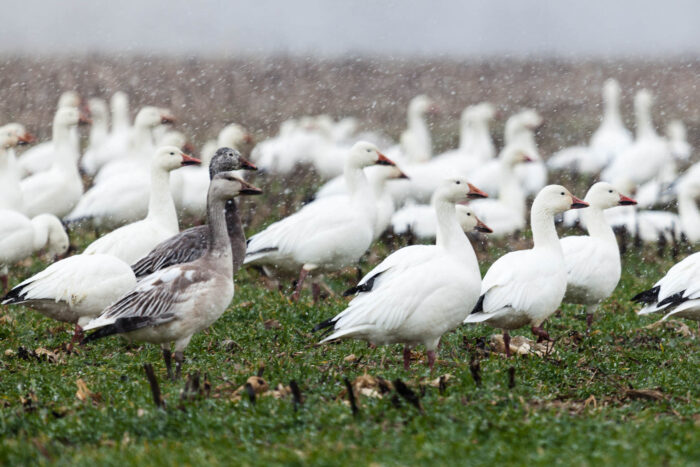Snow Goose
Chen caerulescens
The snow goose is a plump, white bird that visits the Chesapeake Bay region in winter.
This section shows one large critter image at a time. Use the thumbnails that follow to select a specific image to display here.

This gallery contains a grid of small thumbnails. Selecting a thumbnail will change the main image in the preceding section.
Appearance
In its "snow" phase, the snow goose's body is mostly white with black wingtips; in its "blue" phase, its body is grayish-blue. It has a pink, serrated bill with a black "grin patch" on the side, and its feet and legs are red. Adults grow to about 38 inches in length with a wingspan of 59 inches.
Feeding
These birds are herbivores who use their strong, serrated bills to dig roots out of the ground. They feed on marsh grasses, including rushes and cattails, and forage in farm fields for grass, clover and grains.
Predators
Foxes prey on eggs and young geese on breeding grounds. Humans hunt adult snow geese.
Flight
Flocks fly in long, diagonal or V-shaped patterns. Snow geese can be identified in flight by their white bodies and dark wingtips.
Voice
Their call is a shrill, nasal la-uk or houck-houck.
Reproduction and life cycle
Snow geese do not breed in the Chesapeake Bay region; they return to the Arctic tundra to breed, where nesting colonies can number in the tens of thousands. White geese interbreed with those in the blue morph, tending to choose a breeding partner that resembles their parents’ coloring. Monogamous pairs usually form long-term bonds.
Shallow depressions in the ground serve as nests, and are lined with dry vegetation and down from the mother's body. Females lay three to five eggs, which are incubated for 23 to 25 days. Young fledge within 45 days and reach maturity in two years. The lifespan of the snow goose is unknown, but is believed to be more than 15 years in the wild.
Did you know?
- The snow goose has one of the largest populations of any goose in the world. Snow geese rank behind only Canada geese in population size and harvest.
- The blue goose was once thought to be a distinct species, but is now known to be a dark phase of the snow goose. A snow goose’s color is determined by genetics.
Sources and additional information
- Life in the Chesapeake Bay by Alice Jane Lippson and Robert L. Lippson
- Chesapeake Bay: Nature of the Estuary, A Field Guide by Christopher P. White
- Animal Diversity Web: Anser caerulescens – University of Michigan Museum of Zoology
- All About Birds: Snow Goose – The Cornell Lab of Ornithology
- Chen caerulescens – U.S. Forest Service
